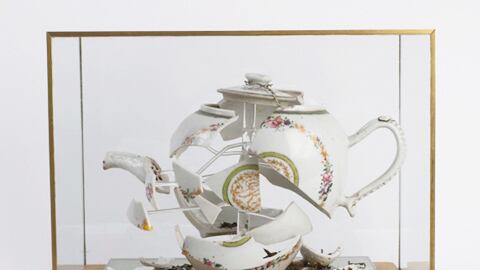One characteristic peculiar to today’s hugely enlarged, all enveloping art world is the phenomenon of those (few) individuals who have followed non-art careers, who have become visual artists by happenstance or second choice, and who have found an art-world success that has eluded most professionals. For instance, the British artist Polly Morgan began as a taxidermist.
VIEW OUR GALLERY OF BOUKE DE VRIES

Now the new-fledged career of Bouke de Vries is offering encouraging proof that, recession or no, collectors remain hungry for new stimulants. De Vries studied fashion and textiles at Eindhoven in the Netherlands, his homeland, then at Central St. Martin’s, London. He entered the fashion world and did well there, working with, among others, John Galliano and Zandra Rhodes, before seeking greater autonomy. Good with his hands and with a keen eye, de Vries retrained as a restorer of art and precious objects. He was soon flourishing. Now in his mid 40s, his clients include the U.K.’s National Trust.
De Vries also developed a kind of an itch, a bug. It bothered him more and more that a tiny chip or a crack would damage or destroy the market value of a tremendous piece of china, a masterwork of glassware. “I started thinking about the futility of it,” he explains. “It’s still got all the history, it’s still got all the skills of 200 or 300 years ago. But it’s worth a fraction of what it would have been worth before it was damaged. It seemed rather bizarre.
“I have actually been left some objects by customers. After I gave them the estimate they said, 'Oh, don’t bother! Just throw it away. It’s not worth spending that much money on it!' And I thought this is sort of wrong. I’ve just got to do something with this. To give it its dignity back, to put it in a different context.”
The pivotal event was the breaking of a present de Vries had been given by his longtime partner—and, full disclosure, my former editor—Miles Chapman. The figurine of a Dutch boy in white Parian Ware, it had been shattered into dozens of pieces during a move.
“I repaired that because it’s very beautiful,” de Vries says. “I made them all floating. Frozen, like in an explosion. And on the inside I gave him a little red heart.”
Breaking into the art world has been as smooth as breaking into art-making.
“I hadn’t really shown the work to anybody apart from some friends up until three months ago because I wanted to build up a group of work,” he says. “There was no point in showing somebody two pieces and saying this is the idea. Do you get it?”
One of the friends who had seen the work—de Vries had given her a piece—was Meredith Etherington-Smith, a locomotive of the London art world. Etherington-Smith, in turn, told Kay Saatchi, a curator with an expertise in emerging artists. Saatchi, who had been charged with choosing artists for a show organized by Flora Fairbairn’s Murmur art in Selfridges Wonder Room, took herself off to see de Vries’ work.
Saatchi loved de Vries’ pieces, saw the connection to Dutch still life and plonked him in the show. It opened June 30 and he quickly sold five pieces, with the first going to one of London’s more keenly watched collectors, Anita Zabludowicz.
“It’s gone all so quickly, “ says de Vries, who frequently scours London’s Portobello Road for inspiration. “I mean when we travel we go to flea markets. But Portobello is still the best. Because of England’s history, with China and everything, they have the biggest supply and the best supply of good-quality things. I can buy a beautiful broken Worcester for £10. It’s ridiculous! Because it’s still beautiful.”
For now, de Vries is still keeping his day job, but he plans to devote more time to his art.
By the way, which piece did Zabludowicz buy?
“It’s in a glass dome with a NO NO NO on it,” de Vries says. “It’s a portrait of Amy Winehouse. I found that figure. It was a Samson copy of a Meissen and she was the muse of music, that figure. And she was broken. I thought broken? The muse of music? So I did the whole hairstyle, using the restoration techniques. So it looks like a porcelain hairdo that has always been there. But it hasn’t. And it’s got a little syringe coming out of her arm as well. But it’s nothing horrible. It’s a tribute. I think she’s amazing. But broken!”
Plus: Check out Art Beast, for galleries, interviews with artists, and photos from the hottest parties.
Anthony Haden-Guest writes a weekly column on art collecting for the Financial Times. His writing has also appeared in The New Yorker, Vanity Fair, The Times (London), and many other publications. He is the author of several books, including True Colors: The Real Life of the Art World. He lives in New York and London.





